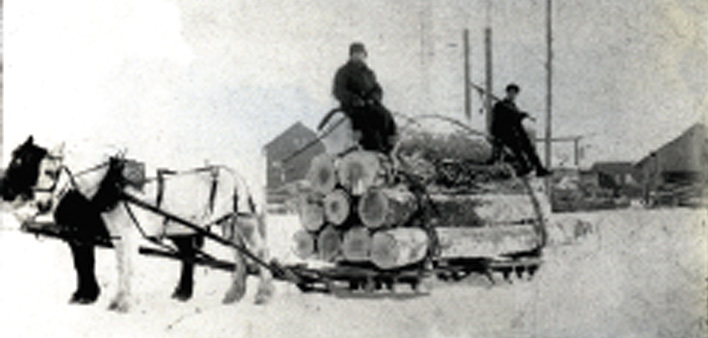Cutting The Great Timber – 1870

By Denis LeDuc
The timber, some trees as much as eight feet in diameter, stretched endlessly across the Michigan frontier in the 19th century. Great stands of hardwoods in southern Michigan and pines further north drew pioneer lumbermen from Maine and New York.
It is hard to conceive, but Michigan’s great forests yielded more money and more fortunes than did all the gold mining in California. It was a physically demanding, dangerous, but lucrative business.
The great forests slowly gave way to the relentless push of the pioneers westward. As communities developed and grew, the sawmills were built and frame houses replaced the crude log cabins. In 1865, Fred Eberlein built a sawmill in the thriving area of Fraser in Macomb County.
The mill sawed not only building lumber for local houses, barns, stores, shops, and churches, but also specialized in barrel staves and heads, which were used by the cooper to build the sides and ends of the barrels.
The mill passed through various hands. By the 1870s, it was owned by Charles Knorr and Charles Steffens. It was considered one of the finest woodworking mills in southeastern Michigan and shipped surplus lumber on the Grand Trunk Railroad to market in Detroit, Toledo, Cleveland, Buffalo, and beyond. The sawmill was the largest employer in Fraser. Steffens eventually bought out Knorr and the mill became the Steffens Lumber Mill.
Fraser was largely a German farming community, and Charles Steffens was born on River Rhine in Germany in 1835 and emigrated to Michigan in 1854. He married his wife Caroline and they started a family. In the 1870s, when Knorr and Steffens took over the lumber mill, Fraser was a thriving village. It was incorporated in 1894 by the State, and Charles Steffens became the fi rst president of Fraser. The sawmill prospered well into the 20th century.
Look carefully at our photo of logging in Fraser as the horses and driver pause for the photographer. Notice that the logs are loaded onto a horse drawn sled rather than a wagon. The logs are securely chained. The rugged lumbermen appear to be employees of Steffens Mill. The mustached driver is dressed in a heavy long coat and cap and holds the reins and whip in his hands. The lumberman on the right holds a peavey, a spiked and hooked tool to grip and roll the logs. In the right rear of the photo is the Steffens lumber mill, with more large logs stacked in front of it, waiting to be sawn into lumber.
Charles Steffens continued as a successful businessman and public servant until his death in 1918. At various times in his long career, he not only ran the family’s lumber mill business, but also engaged in business, real estate development, coal, farming, and a feed mill. He served not only as a Village President but also a Justice of the Peace.
The Steffens Lumber Mill thrived well into the 20th century.
Photos, courtesy of the Fraser Historical Commission.

